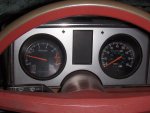Welcome to TRS

1987 was the last year for the AMP gauge on the dash, so it has a different wiring setup that later years
But it could be either way, an AMP gauge(+ and -) or a Voltage gauge with numbers on the dash
Which do you have?
The AMP gauge wires were in that larger wire you replaced that ran from B+(back of alternator, a stud nut terminal) to the starter solenoids Battery positive terminal(post)
You don't need them but you DO NOT want to hook them up without the Shunt, which would have been destroyed if the larger wire was
AMP gauge used a Red/orange wire and a Yellow green wire, leave them disconnected, for now
Its easy to test charging system
Test battery voltage first, remember it
Key OFF
Use alternators metal case as the Ground for volt meter
Test voltage on B+, should be battery voltage, exactly
If not new wire is bad, this wire NEEDS to have a fusible link to continue to work
Unplug 3 wire connector on the back of alternator
Test Yellow wire, should be Battery voltage
If not its disconnected or burned out
Test green wire, should be 0volts
Turn key ON, engine off
Re-test green wire, should now see battery volts
If not then ignition switch may be damaged
Green wire is the ON/OFF switch for alternator, no 12v here with key on means no charge, 12v all the time means drained battery
Check that White jumper wire is plugged into its single spade terminal and not frayed
And that's it, truck system is tested once those 3 voltages are reading correctly
Start engine
test battery volts, should be 14.1 to 14.8volts, if lower than 13volts, alternator is bad, no maybe
Can't test alternator at auto parts store, just FYI, you can test alternator in a vehicle by doing the above wiring tests
If the 3 wires are OK and alternator doesn't raise voltage above 13.5volt with engine running then its bad, period
Its not that complicated of a system













